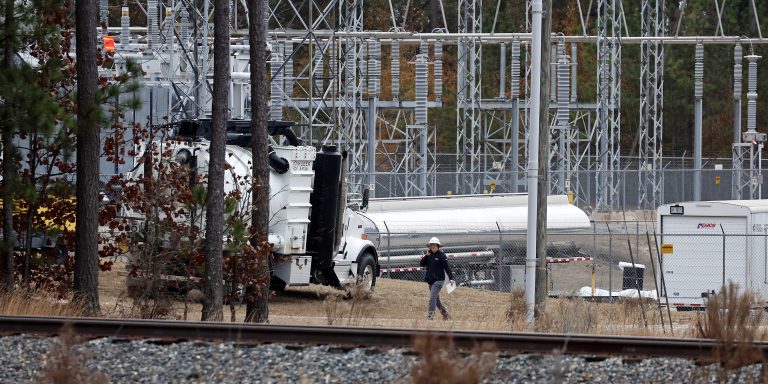INTELBRIEF
February 10, 2023
IntelBrief: Far-Right Extremists Continue Obsession with Targeting Critical Infrastructure

Bottom Line Up Front
- Recent arrests of neo-Nazis in the United States who planned to target the power grid in Maryland demonstrate the persistent risk posed to critical infrastructure and “soft” targets.
- One of those arrested, Brandon Russell, is a founding member of Atomwaffen who promoted accelerationism and sought to instigate terrorist attacks to spark a race war in the U.S.
- Attacks against critical infrastructure have long been high on the agenda of violent extremists, with planned and foiled attacks across the United States against dams, electrical systems, and energy sites.
- Online, in Telegram and other platforms, American far-right extremists speak openly of attacking the power grid in the United States in an attempt to hasten the downfall of the government.
Recent arrests of neo-Nazis in the United States who planned to target the power grid in Maryland demonstrate the persistent risk posed to critical infrastructure and “soft” targets. Brandon Russell, one of the founding members of the white supremacist group Atomwaffen Division, and Sarah Clendaniel, whom Russell met in prison, were charged with conspiring to destroy an energy facility, a charge which carries a possible twenty-year sentence. The plot was disrupted with the help of local, state, and federal law enforcement entities working together to share information. Russell and Clendaniel are considered racially and ethnically motivated violent extremists (REMVE), owing to their neo-Nazi ideological beliefs. Clendaniel left behind writings that showed an infatuation with Adolf Hitler, Ted Kaczynski (the Unabomber), and Anders Breivik, the far-right terrorist responsible for the racially motivated 2011 attacks in Norway, which killed 77 people in Oslo and Utøya, respectively. She also commented, “I would sacrifice everything for my people,” referring to the white race. White supremacist extremists have also been unequivocal in their quest to build and detonate a dirty bomb, with the intent of killing large numbers of people and destabilizing the country.
Russell, a former member of the Florida National Guard, spent five years in prison after pleading guilty to possessing an unregistered destructive device and illegally sorting explosives. As a founding member of Atomwaffen, Russell promoted accelerationism and sought to instigate terrorist attacks that he believed would spark a race war in the United States. The goal in this particular plot was to attack at least five separate electrical substations around Baltimore, with the intent of taking the entire power grid offline in the city. If successful, the attack would have knocked out power to homes, businesses, and medical facilities. The plot was apparently in the advanced planning stages and would involve targeting transformers, which take longer to repair and replace. CISA, the Cybersecurity and Infrastructure Security Agency in the U.S., has been on high alert with increased attention being paid to attacking the power grid. There have been calls by public officials to increase funding and security surrounding the most vulnerable sites.
Attacks against critical infrastructure and “soft” targets have long been high on the agenda of various far-right extremists. The logic is that attacking power grids will lead to broader societal chaos, thus enabling the collapse of the U.S. government or, “the system.” Targeting infrastructure is also intended to cause casualties and demonstrate the potency of the white power movement to both its adherents and adversaries. The plot to attack critical infrastructure in Maryland comes on the heels of several attacks against power stations within the United States. In December, gunfire at two substations in North Carolina disrupted power and electricity for several consecutive days, impacting about 45,000 people. Other similar attacks have gone unsolved. According to a report by the George Washington University Program on Extremism (GWU PoE), between 2016 and 2022, white supremacist plots targeting energy systems increased drastically—eleven of thirteen attackers planning strikes against the energy sector were charged after 2020. The U.S. Department of Homeland Security (DHS) has repeatedly warned against attacks by far-right extremists against the U.S. electric grid.
This tactic of attacking critical infrastructure is not new. There were attempts by extremists to attack the Hoover Dam in the 1980s, as well as plots seeking to poison local water supplies with cyanide. In 2013, several gunmen opened fire on a transmission substation south of San Jose, California, causing approximately $15 million worth of damage to 17 transformers. Online, in Telegram and other platforms, far-right extremists speak openly of attacking the power grid in the United States in an attempt to hasten the downfall of the government. In 2022, there was a string of attacks on electrical substations throughout the Pacific Northwest, including attacks in Oregon and Washington state, which remain unsolved. Extremists have also discussed attacking nuclear reactor sites in an attempt to generate a mass casualty incident that would also serve as a propaganda boost for the violent far-right movement, which gained increased credibility in the aftermath of the U.S. Capitol insurrection of January 6, 2021, particularly by mainstreaming extremist positions into a deeply polarized political environment in the country and generating a veneer of legitimacy for those views among even senior political figures.